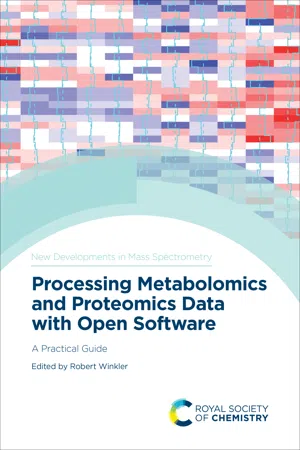
Processing Metabolomics and Proteomics Data with Open Software
A Practical Guide
- 430 pages
- English
- ePUB (mobile friendly)
- Available on iOS & Android
Processing Metabolomics and Proteomics Data with Open Software
A Practical Guide
About this book
Metabolomics and proteomics allow deep insights into the chemistry and physiology of biological systems. This book expounds open-source programs, platforms and programming tools for analysing metabolomics and proteomics mass spectrometry data. In contrast to commercial software, open-source software is created by the academic community, which facilitates the direct interaction between users and developers and accelerates the implementation of new concepts and ideas. The first section of the book covers the basics of mass spectrometry, experimental strategies, data operations, the open-source philosophy, metabolomics, proteomics and statistics/ data mining. In the second section, active programmers and users describe available software packages. Included tutorials, datasets and code examples can be used for training and for building custom workflows. Finally, every reader is invited to participate in the open science movement.
Frequently asked questions
- Essential is ideal for learners and professionals who enjoy exploring a wide range of subjects. Access the Essential Library with 800,000+ trusted titles and best-sellers across business, personal growth, and the humanities. Includes unlimited reading time and Standard Read Aloud voice.
- Complete: Perfect for advanced learners and researchers needing full, unrestricted access. Unlock 1.4M+ books across hundreds of subjects, including academic and specialized titles. The Complete Plan also includes advanced features like Premium Read Aloud and Research Assistant.
Please note we cannot support devices running on iOS 13 and Android 7 or earlier. Learn more about using the app.
Information
Open MS Programs, Toolkits and Workflow Platforms
d Department for Computer Science, Applied Bioinformatics, University of Tübingen, Sand 14, 72076 Tübingen, Germany
e Biomolecular Interactions, Max Planck Institute for Developmental Biology, Max-Planck-Ring 5, 72076 Tübingen, Germany
f Institute for Translational Bioinformatics, University Hospital Tübingen, Hoppe-Seyler-Str. 9, 72076 Tübingen, Germany
g Institute for Biomedical Informatics, University of Tübingen, Sand 14, 72076 Tübingen, Germany
h Quantitative Biology Center, University of Tübingen, Auf der Morgenstelle 10, 72076 Tübingen, Germany
i Epigenetics Institute, Department of Cell and Developmental Biology, University of Pennsylvania, 9th Floor, Smilow Center for Translational Research 3400 Civic Center Blvd, Philadelphia, PA 19104, USA
j Department for Computer Science, Algorithmic Bioinformatics, Freie Universität Berlin, Takustr. 9, 14195 Berlin, Germany
k STORM Therapeutics Limited, Moneta Building, Babraham Research Campus, Cambridge CB22 3AT, UK
*E-mail: [email protected]
Computational mass spectrometry is plagued by a multitude of issues, including a heterogeneous software environment, complex workflows and proprietary tools. OpenMS addresses these challenges by providing robust open-source software for users and an open, well-designed software environment for developers. OpenMS is an open-source software C++ library for LC-MS data management and analyses using modern C++11. It offers an infrastructure for rapid development of mass spectrometry related software. OpenMS is free software available under the three clause BSD license. It comes with a variety of pre-built and ready-to-use tools for high-throughput Proteomics and Metabolomics data analysis (TOPPTools), covering most MS and LC-MS data processing and mining tasks, as well as visualization (TOPPView). OpenMS offers automated analyses for various quantitation protocols, including label-free quantitation, SILAC, iTRAQ, TMT, SRM, SWATH. It provides built-in algorithms for de novo identification and database search, as well as adapters to other tools like X!Tandem, Mascot, OMSSA, SIRIUS. It supports easy integration of OpenMS built tools into workflow engines like KNIME, Galaxy, WS-Pgrade, and TOPPAS. OpenMS supports the Proteomics Standard Initiative (PSI) formats for MS data including mzML, mzXML, mzIdentXML, pepXML. With pyOpenMS, OpenMS offers Python bindings to a large part of the OpenMS API to enable rapid algorithm development.
6.1 Introduction
6.2 OpenMS for Developers
6.2.1 C++ Library
Table of contents
- Cover
- Half Title
- Series editors
- Title
- Copyright
- Preface
- Contents
- Part A General Section
- Part B Open MS Programs, Toolkits and Workflow Platforms
- Part C Conclusion
- Subject Index